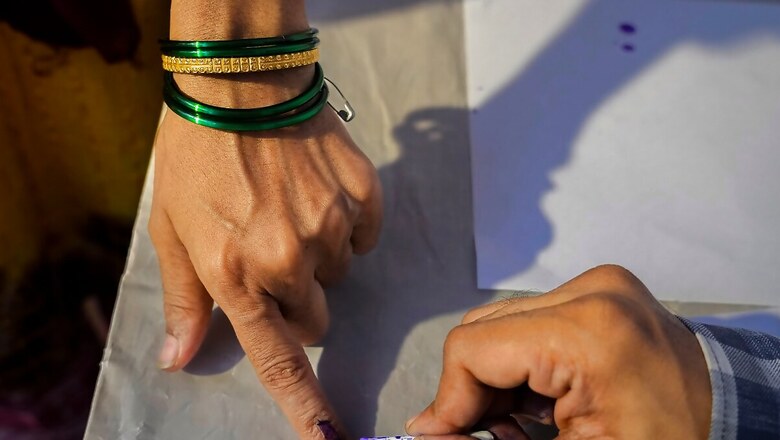
views
Ghosi Lok Sabha constituency is one of the 80 parliamentary seats in Uttar Pradesh. It comprises the following assembly segments: Madhuban (BJP), Ghosi (SP), Muhammadabad-Gohna (SP), Mau (SBSP) and Rasara (BSP).
Atul Rai from the Bahujan Samaj Party (BSP) is the incumbent MP here, though the election ticket this time has gone to Balkrishna Chauhan. Rajeev Kumar Rai from the Samajwadi Party (SP), who is the joint candidate of the opposition INDIA bloc and Suheldev Bharatiya Samaj Party (SBSP) leader Arvind Rajbhar, who is representing the ruling National Democratic Alliance, are the other key candidates in Ghosi where polling will take place on June 1 in the seventh and final phase of the Lok Sabha elections.
Political dynamics
NDA on Weak Footing: The only victory for the BJP from the Ghosi Lok Sabha constituency came in 2014 when the party won the seat by 1.46 lakh votes. In 2019, the BSP reclaimed its fort as Atul Rai defeated the saffron party’s Harinarayan Rajbhar. This time, the BJP has not fielded its own candidate but has instead given the seat to NDA partner Om Prakash Rajbhar’s SBSP.
Om Prakash Rajbhar has fielded his eldest son Arvind from Ghosi. However, the NDA’s problems in this parliamentary seat are many. For starters, voters are not able to digest the fact that Om Prakash Rajbhar, who spent the better part of his time in the Samajwadi Party abusing and using unparliamentary language against the BJP and its top leaders, is now fighting the election alongside the saffron party. This has led to considerable confusion on the ground.
While voters may simply be confused and of the view that they are being asked to vote for a turncoat party, the NDA’s prospects are also taking a hit due to a lack of coordination between the BJP and SBSP. This is because while the party’s top leadership may have forgotten Rajbhar’s incendiary remarks against saffron leaders, the cadre and volunteers on the ground have not. BJP workers are not enthusiastic about campaigning or pitching for a candidate like Arvind Rajbhar, whose father went to the extent of abusing Yogi Adityanath and saying the chief minister should retire to some “mandir or math” and play the “ghanta”, or the bell there. There is significant disillusionment among BJP’s cadre over the party giving up its claim on the seat for Om Prakash Rajbhar, who has a distinguished legacy of switching sides when it suits his political interests.
Another big problem which the BJP is encountering is that voters are not very inclined to support the “stick symbol”, which represents Om Prakash Rajbhar’s SBSP. While the Rajbhar vote, numbering about two lakh, is sticking with their party, the other castes and communities which have supported the BJP previously are now in a state of flux. The Rajbhars too, as a matter of fact, poll just between 1 to 1.2 lakh votes every election. Ground inputs suggest that if the BJP had fielded its own candidate on the “lotus symbol”, or even if Arvind Rajbhar was contesting on the symbol, victory would be within the party’s reach. At present, however, the NDA’s prospects here do not look very bright.
On the ground, there is no perceptible anger or disillusionment against either Prime Minister Narendra Modi or CM Yogi Adityanath. Voters generally appreciate the Centre and state’s schemes, especially those that have provided them with basic amenities. Voters have seen development take place; even as free ration remains a big plus point for the BJP. This is one seat where the BJP’s prospects have been spoilt purely due to poor ticket distribution.
The BJP is aware that Arvind Rajbhar’s candidature could prove costly for the party here in Ghosi. Perhaps this is why, in a recent video, the SBSP candidate was seen doing sit-ups while holding his ears, ostensibly to apologise for his and his father’s erratic remarks against the BJP. To an extent, this has helped the SBSP tide over some of the anger it faces from the BJP’s cadre.
The BJP hopes that PM Modi and CM Yogi’s campaigns here will provide voters, especially BJP’s core support groups, with sufficient reason to step out of their homes on polling day and cast the ballot in favour of the stick symbol. It’s a big ask, which is why the BJP is also relying on this constituency’s history of never re-electing an incumbent MP since 1998.
SP Has Upper Hand amid BJP, BSP Voter Flux: The SP has fielded Rajeev Kumar Rai from Ghosi to take on the NDA and BSP here. The fight is triangular between the SP, BSP, and BJP. The BSP appears to be holding on to its core voter base, but given Atul Rai’s inability to work for this constituency over the past five years, Mayawati’s party stands in a disadvantageous position. The BSP’s core voter base comprises Dalits, OBCs, and Chauhans.
The Samajwadi Party seems to have the upper hand here, primarily because there seems to be some movement of pro-BJP castes towards it. This is apart from the Muslim-Yadav vote bank that the SP has in its pocket already. While the BJP’s core voters may be shifting towards the SP, there is a strong likelihood of a considerable number of Dalits and OBCs voting for the BJP. To an extent, this may help the saffron party neutralise the voter attrition it faces.
Muslims, who number about 3 lakh here, apart from the Yadavs, who make up about 2 to 2.5 lakh of the demography, give the Samajwadi Party a readymade vote bank of roughly 5 lakh votes. Besides, Rajeev Rai’s clan is set to provide the SP with roughly 30,000 to 40,000 additional votes.
The SP and BSP both have considerable influence in this constituency, which is why on the ground there are plenty of voters who voice their disappointment with the BJP and the Modi government. Coming from within the Samajwadi and BSP support bases, such voters highlight exam paper leaks, unemployment, and inflation as the big reasons why people should steer clear of the BJP.
The Dalit vote, in many ways, holds the key in this election. It cannot be said with surety which way the SCs are set to vote this time. These are people who benefit from the Centre and state’s welfare schemes, and are among the “labharthi” (beneficiary) class of voters. Ground inputs suggest this vote bank, originally belonging to the BSP, could now incline towards the BJP. That has the potential of placing the SP on a backfoot.
Numerically, each party can claim a significant support base in Ghosi. However, the SP does have an advantage in this aspect. More than the mathematics though, the election of Ghosi will also depend on various parties’ chemistry with voters. It is here that the BJP hopes to trump the SP, owing to the Modi and Yogi factors. Still, in a battle between the cycle and the stick, it will be difficult for the NDA to register a win from this constituency. If it does, and the SP candidate is indeed defeated, the BJP would have achieved quite a feat in Ghosi.
Demographics
- Total Voters: 19,85,203
- SC: 424,833 (21.4%)
- ST: 25,808 (1.3%)
- Rural: 1,590,148 (80.1%)
- Urban: 395,055 (19.9%)
- Muslims: 17%
- Turnout in 2019: 57.1%
Key issues
No Lotus Symbol: For voters in Ghosi, the fact that the BJP’s lotus symbol will not be on EVMs come polling day is a matter of grave disappointment. Interestingly, the party giving up the seat to the SBSP has become a big issue in Ghosi, as traditional BJP voters contemplate either sitting the election out or voting for the SP candidate. The Rajbhar family’s recent history of abusing the BJP and its leadership has unnerved many in the saffron camp, especially the cadre. They have not been enthusiastically canvassing votes for Arvind Rajbhar, even as the SP gives its all in the fight. Ground inputs suggest the BJP stood a good chance of winning the seat if a candidate was fielded on the lotus symbol. The stick symbol is just not exciting voters as much as the NDA would like it to.
Sugar and Cotton Mills: Unemployment is a big issue in Ghosi, and exacerbating the problem is the closure of a cotton mill in the constituency. A sugar mill, meanwhile, is operating at losses and not providing as many employment opportunities for the people as it should. Other smaller mills are also closed, which has become a big cause of worry for the people. No new industrial unit has come up, forcing people to look for jobs in other areas. Among the youth especially, the anger against unemployment is becoming increasingly pronounced. Meanwhile, those involved in the saree business have to sell at steep losses in Varanasi and other urban centres of Uttar Pradesh, bringing a downturn in incomes.
Missing MPs: The Ghosi constituency has a legacy of witnessing its MPs land behind bars for a variety of reasons, leaving the people here without a representative in the Lok Sabha. Besides, voters also complain about their MPs not interacting on a regular basis with them, who are, as a result, left to fend for themselves. This could be why the constituency has not re-elected an incumbent MP since 1998.
Paper Leaks and Education: There are demands, especially from the youth, for the education scenario to be given a facelift here. Demands for scholarships are also gaining traction. Meanwhile, since the constituency has come to be known as a paper leak hub of sorts, there is also disgruntlement over the repeated nullification of exams. This affects the employment scenario, as many government job aspirants are forced to appear many times for the same examination because the question papers get leaked.
Healthcare: Although the healthcare scenario has improved in terms of infrastructure, the non-availability and shortage of doctors and trained medical professionals remain a concern. The upgraded facilities are not of much use if there are not enough doctors available, which is exactly what is seen in Ghosi.
Infrastructure development
Civic Infra: The overall infrastructure of the constituency, in terms of roads and access to basic amenities, has been given a fillip in recent years, most of the credit for which goes to AK Sharma, the state energy minister. He hails from the constituency and has used his position in the state government to bring significant changes to Ghosi. Beautification work has also been undertaken, which is visible to voters. Access to water and electricity has been improved.
Roads and Connectivity: The road network has been improved in Ghosi, with the government in 2022 deciding to turn the Bansdih-Balia- Ghosi highway into a four-lane route, easing connectivity and bringing down travel time. Separately, the Purvanchal expressway from Balia-Ghazipur to Azamgarh is also helping people better access the region. AK Sharma is also credited with improving rail connectivity in the region, by recently facilitating the launch of two new trains here.
Medical College: A new medical college is set to be constructed in Ghosi under the public-private partnership model. However, despite the foundation stone being laid, any meaningful work is yet to begin.
(With Abhishek Rai)
Explore in-depth coverage of Lok Sabha Election 2024 Voter Turnout, Upcoming Phase, Results Date, Exit Poll And Much More At News18 Website














Comments
0 comment